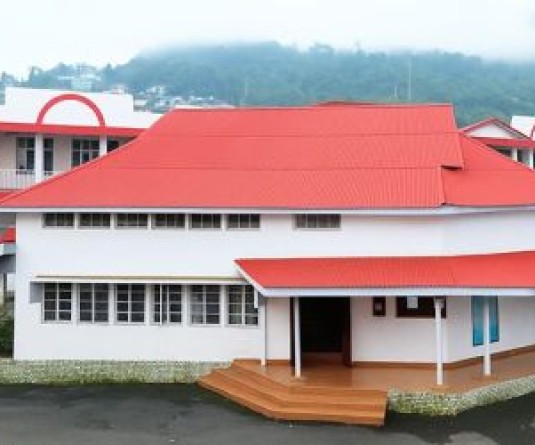Governor Ashwani Kumar, Chief Minister Neiphiu Rio and others during the release of the Primary Census Abstract of Nagaland in Kohima on Thursday. (Morung Photo)
Chizokho Vero
Kohima | June 6
With the release of Primary Census Abstract of Nagaland today, the state is now all set to use this final Census-2011 data in all its planning process. A Primary Census Abstract of Nagaland brought out by Directorate of Census Operations, Nagaland was released by Governor Ashwani Kumar in the presence of chief minister Neiphiu Rio, council of ministers, parliamentary secretaries, chief secretary Alemtemshi Jamir, V. Hekali Zhimomi, director of census operations and many other dignitaries.
Touching on total population of the state which has decreased from 19,90,036 in 2001 to 19, 78,502 in 2011, Dr. Kumar said “ This apparently shows a negative 0.6% decadal growth rate. It takes a lot of courage to challenge your colleagues and do it successfully. These officers have done it and on the touch stone of truthfulness and professionalism.” “Hats off to the officers and staff of Nagaland Census for showing courage and re-establishing that ‘truth still prevails,” a visibly impressed Governor said.

Referring to state’s literacy rate of 79.6% which is above the country’s literacy rate of 73% and the female literacy rate at 76.1% which is once again higher than the entire country’s female literacy rate of 64.6%, Dr. Kumar said “These are good indicators of human development but we must also look at the other side of these statistics.” There are wide disparities across some of the districts and sub divisions. While Mokokchung district has the highest literacy rate of 91.6%, on the other side, Mon district has a literacy rate of 57% only. Similarly, female literacy rate in Mokokchung district is the highest that is 91%, whereas Mon district has a female literacy rate of 52.6%. “There is no need to be discouraged by these figures. On the other hand we must view these as a challenge for the future,” he said adding that such statistics should help us in allocating more resources to improve the situation in these areas.
Also stressing on the need to ensure equity in accessibility to education, Dr. Kumar said “ The areas which have enough infrastructures need to start concentrating on quality education now, especially in science and technology.” Referring to rapid urbanization taking place in the state, he said the trend of urbanization is irreversible. Stating that our towns are always going to draw people in search of better opportunities, better education and better civic amenities,” he stressed on the need to have a vision to ensure that as people flow in towards towns and towns expand, “We must put in place drainage and sanitation facilities, wider and well- planned roads, parks and recreation/shopping centres.”
We need a long term policy based on a clear vision of the future, to cater to the demands of urbanization, he added. Viewing that all future urban areas and cities will expand in linear shape, that is along highways and railways lines rather than along rivers or tops of hills, as was the case earlier, the Governor also stressed on the need to plan housing, industrial estates, water and electricity supply along the roads and highways. The Governor said that a matter of concern is the sex ratio in the state. It is 931, which is below the country’s sex ratio of 943. “This is surprising, given the fact that the Naga society is known to be far more egalitarian than many other societies.” Dr. Kumar urged the planners of the state to look within and beyond the date because, the data also shows disparity across the various districts of the state. We all know the importance of having a balanced sex ratio in our society and the need to provide equal opportunities to males and females in all aspects of our socio, economic and political life, he added.
Terming 2011 census as an important exercise for the state, Chief Minister Neiphiu Rio was optimistic that the data will help in the crucial planning exercise of the state. Rio said the data reveals the socio-economic condition of the state and villages and towns. “Our state is still a growing state and hence, this is the right time to start planning for our state based on the facts being presented by the Census Data,” he said adding that the census data will assist the government in ensuring a need based planning process which in turn will lead to equity in growth, development and benefits for people living in the urban and rural areas. Referring to high literacy rate, Rio said “While this is good and reflects well on the human resource potential of our state, it also means that we must create more employment opportunities to absorb the tremendous educated manpower we are generating.”
He stressed on the need to encourage entrepreneurship and creative ventures to industrialize the state, “because it is only through industrialization that we can absorb our educated youth into gainful employment, and turn our state from being a consumer state to a producer state.”
Rio said the data on work was also of particular importance because it reveals that 49.2% of our people are manual workers. Of these, majority are cultivators. “To my mind, this data reveals just how much of importance we must pay to agrarian sector of our economy. Majority of homes in Nagaland, particularly in the rural areas are entirely dependent on agriculture for their livelihood,” said Rio and adding our planning process must take this into consideration and put in place appropriate programmes that will increase our productivity.
On the population of the state that has recorded a negative growth rate and is less than 2001 census by 11,543 persons, Rio said “This only reveals that the people of Nagaland have not repeated the mistakes that we have committed in the past, but we have had the courage to ensure a correct census.” “There should be no fear of being small in number-as a village, town or district, state or as a people. It is not only how many we are that matters, but who we are that really counts. As Nagas we should be known for our courage, integrity and unity, irrespective of our numbers,” said the chief minister.
Rio recalled that the state cabinet had rejected the figure/data of the previous 2001 census “due to its inaccuracies,” adding that it further took a political decision to have accurate and reliable census 2011. He congratulated and thanked the Directorate of Census Operations, Nagaland, the people involved, the tribal Hohos, the churches, NGOs, civil societies, the GBs and village councils etc, who have come forward to get the most accurate and satisfactory census 2011. Stating that the state now has a “very accurate and reliable data,” Rio stressed on the need to immediately use the same in all planning process to ensure better and more equitable development across our state, adding that equity in development will ensure that “we do not discriminate against one another in our efforts to grow as a strong and developed state.” Rio also stated that the 2011 census will no doubt help in formulating a better blue print for future development of the state.
Later Rio released the Village Level Data Census 2011 while Chief Secretary AlemtemshiJamir IAS released interesting and fun facts Census 2011.






